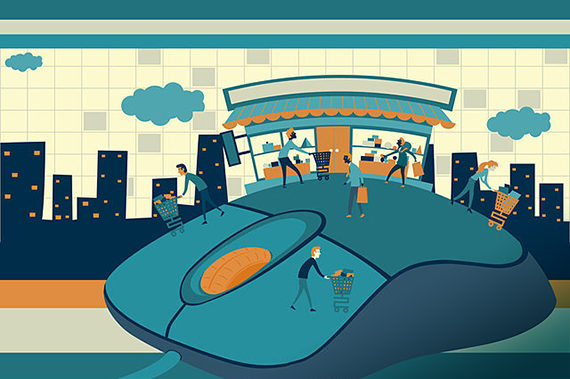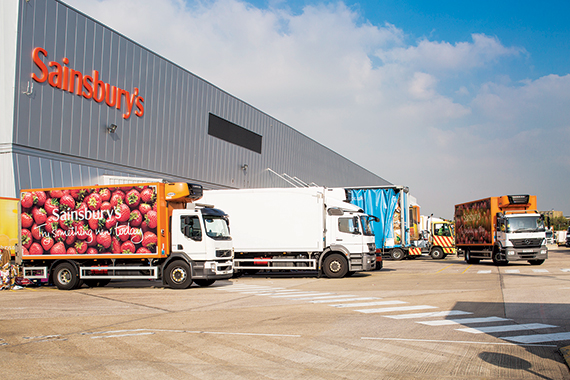What’s in store for the UK’s top supermarkets as they battle to secure more space to enhance their retail offering to customers? Neil Tague reports
 There is a reason why the phrases “time is money” and “we live in the age of instant gratification,” are clichés – it is because they are true. We want everything now, and will pay for it. It is this 21st century impulse that is driving retailers to ever speedier customer service.
There is a reason why the phrases “time is money” and “we live in the age of instant gratification,” are clichés – it is because they are true. We want everything now, and will pay for it. It is this 21st century impulse that is driving retailers to ever speedier customer service.
In August, Tesco announced that it would offer a same-day click and collect service, a direct response to the launch of Amazon Fresh in June, aimed at the online giant’s London-based Prime customers.
While Sainsbury’s has soft-launched a same-day click and collect service from a handful of stores, Tesco has promised 300 larger stores would provide the service. It is simple enough: order before 1pm, collect after 4pm for a charge of £2 (£3 at weekends).
Alistair Allison, partner at Tuffin Ferraby Taylor, describes the impact on logistics as “inevitable”. He says: “Historically, large centralised distribution hubs have been the focus, providing economies of scale in terms of property and operation costs.
“But with rapid response and delivery times demanded, there is a growing need for smaller secondary distribution centres to get the products closer to the ultimate destination sooner, so the final leg of the journey is as short as possible.”
David Binks, partner at Cushman & Wakefield, says that the market is seeing a reconfiguration of networks in reaction to omnichannel retail – ever-expanding stock lines mean more logistics space required.
“There is a lot of interest around click and collect, but for now I think it is about adopting the existing retail footprint. Amazon is a disruptor and people are taking notice – it has the ability to be a massive threat,” says Binks.
The appeal of click and collect is understandable, especially as online deliveries are a loss-leader for most supermarkets. The “last mile” is critical, so why not get the customer to take that burden?
Most agree it is too early to tell how things will pan out and that the big firms have enough wriggle room in their estates to take on more lines – for now at least.
Steve Mitchell, director of industrial at Colliers International, says: “People might prefer to work with what they have got for a couple of years while Brexit pans out – nobody wants to be over-exposed to major capex commitments. I do not see a raft of new requirements.”
Mitchell says that what requirements there are will be smaller and closer to customers. “The established players all have mature networks – only the discounters are still seeking distribution centres. The established players are protecting their positions for now,” he says.
It seems that the hot trend of a couple of years ago, the growth of the “dark store”, has cooled. None of the big grocers operate more than half a dozen. Ocado has the most automated systems, an established hub-and-spoke network and enviably high customer satisfaction.
Another factor in needing space close to customers is the convenience format, which remains lucrative but challenging.
Alan Holland, business unit director at SEGRO, says: “Shoppers are getting back to shopping for fewer items more often. Replenishment is a real challenge because the convenience format stores are in such dense areas.
“There is a debate the policymakers need to have about the intensification of land use in urban areas, especially London,” says Holland.
Competition for space inside the M25 is becoming more intense as the discounters, hungry for more market share, join the space race.
Colin Steele, partner at Rapleys, says: “The discounters have not had the distraction of home delivery, but they do now have a focus on the M25 territories. The likelihood is they will face the same fulfilment challenges as convenience stores.”
However, it is unlikely this will benefit the tired 1990s-built retail warehousing schemes dotting the UK’s ring roads, despite their proximity to people. Steele says: “There is a great reluctance from landlords to change use to warehousing – the last thing they [landlords] want to do is to mark down a retail scheme and stunt rental growth aspirations. Unless a landlord accepts that a site’s an absolute basket-case as retail, it won’t happen.”
He adds: “We will see older warehouses reused provided they have got enough external space for fleets of vans – but an issue with a lot of 1990s ad 2000s stock is it does not have a lot of external space for multiple vehicles.”
Ultimately, as long as no one grocer is romping away with market share, it is a case of honing mature networks.
But Aldi and Lidl remain expansive. Keeping pace with store openings, Lidl has committed to sheds of around 500,000 sq ft each in Sandwell, West Midlands; Exeter; and Bristol in the last 18 months and Aldi to similar numbers in the East Midlands and at Logistics North near Bolton.
Binks warns that retailers should keep an eye not just on the discounters, but the high-end delivery specialists: “The likes of Hello Fresh, Blue Apron and Abel & Cole are serious players now – well funded and growing rapidly. Hello Fresh has taken a 230,000 sq ft unit in Banbury. It knows what it is doing.”

Changing lanes
Just as shopping centres are increasing leisure to increase dwell-time, supermarkets are adding in facilities that make shoppers’ lives easier. Sainsbury’s, which completed its acquisition of Home Retail Group in September, has already started rolling out Argos counters in-store for click and collect, while five mini-Habitat concessions stocking 600 lines will also be trialled.
Tesco has offered space within stores to partners such as Original Factory Shop, soft play centre Funky Monkeys and budget gym Xercise4less.
Joanne Fearnley, partner at law firm Gordons, says: “Retailers generally are moving away from the massive supermarkets, which British shoppers seemingly have not taken to, and are using that space to bring in partners, building footfall and increasing the time people spend in store.”
Even the classic supermarket aisle pattern is being changed in some places, to give a more department store feel. Offering more stock brings challenges, as SEGRO business unit director Alan Holland describes: “In taking on more non-food lines they must cope with ‘reverse logistics’ – the volume of goods bought online that are returned. We are seeing buildings used specifically to deal with returns.
“There is a degree of segregation now between food and non-food, which might become more pronounced. Flexibility is the key, because product lines are changing so much.”
Pick-up tactics
How might collection facilities evolve should demand pick up? Colliers International’s Steve Mitchell says: “So far, retailers are just making their existing real estate work harder. How do you service click and collect – a lean-to in the car park? It is lo-fi but effective. If click and collect takes off, they will need to factor in more storage onsite.”
There is also the possibility of collection from elsewhere, of course – Mitchell is not alone in suggesting specific scaled-down warehouses for collections, not dissimilar to drive-throughs.
Alistair Allison of TFT reckons the appeal will come in getting facilities close to places of work: “The increasing importance of wellness for employers and commercial landlords supports click and collect, as it adds a useful amenity to staff and occupiers. The facilities can be small retail units or simple automated lockers, and provide a useful income stream for business or retail parks.”











